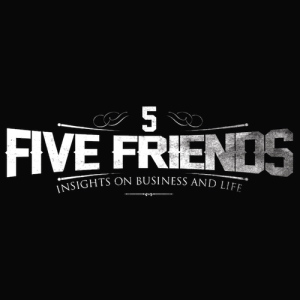
What To Do About the Biggest Problems Facing Business
Five best-selling authors, Speaker Hall of Fame recipients, internationally-acclaimed business consultants and best buddies give their insights on business and life.
In our last blog, The Five Friends each gave their opinion about what they considered to be the biggest problems facing businesses in the next five years. In this blog, each will give their solution to the problem they discussed.
From Randy Pennington:

How do you become more nimble and adapt to change more quickly? Here are five ideas:
1) Change the way you think about change. Our mindset – how we think – drives action and feeling. Nimble companies and leaders think of change as an opportunity to be faster, better, cheaper, and friendlier.
2) Use the power of a compelling purpose and vision to generate urgency. We readily pursue new options and solutions when presented with an important problem to solve or goal to achieve.
3) Use resistance as your friend. Our tendency is to push back when we experience resistance. If you believe that people want to do a good job and succeed, you must learn to accept resistance is a valuable piece of information about a concern or fear that could derail change.
4) Make change and innovation part of the culture. An organization’s culture is defined by its habits. If you want people to be more nimble and adaptable, you must create the expectation, provide the time, and make it safe to do so.?
5) Go first. Leaders set the tone for their organization by action not words. Embrace the opportunities presented by change and people follow you.
Randy Pennington helps leaders deliver positive results in a world of accelerating change. To find out more, go to www.penningtongroup.com.
From Mark Sanborn:

Increasing expectations are among the biggest challenges any business will face in the next five years. Here are eight things you can do about them.
1) Find out what is important to customers: what they require and what they desire. You’re not clairvoyant so routinely ask customers for input.
2) Explain your value proposition when you must say no. If you can’t do something the customer wants, explain why. But see if there is something acceptable you can do instead.
3) Educate customers about the value you create for them. If they don’t know about it or appreciate, it isn’t value.
4) Hold quarterly sessions with your team to brainstorm how to add value to the customer’s experience.
5) Evaluate the entire customer experience. Look for failure points and irritations that can be eliminated and improvements that can be made.
6) Pay more attention to your customers than your competition. Know what your competitor is doing, but put your customer at the center of your focus.
7) Pleasantly surprise customers whenever you can.
8) Treat better customers better. Treat all customers well, but those who spend more should get preferential treatment.
Mark Sanborn is president of Sanborn & Associates, Inc., an idea studio for leadership development. He is an award-winning speaker bestselling author of books including, The Fred Factor. For more information and free resources, visit www.marksanborn.com.
From Scott McKain:

The biggest problem you face – now and in the future – is that there is no distinctive reason for customers to choose you over the competition.
What should you do? Use my Four Cornerstones of Distinction:
1) Clarity. Are you clear about your marketplace advantages (if any, other than price)? Where is your flag planted – the precise spot where you are going to create distinction as a market leader? Is your team on board and in sync?
2) Creativity. What are you doing unique from the approaches that your competition is employing?
3) Communication. Today’s audience can go to Google and discover any piece of information they require. Your style of communication must shift from providing information to delivering insight. How can you help customers receive more value and become more productive?
4) Customer Experience Focus. What does it feel like to be your customer? Is it compelling enough that it ensures both repeat and referral business? If not, you have to step it up.
Goldman Sachs recently reported that 30% of Millennials say they’ll never buy a car. 50% aren’t concerned about buying a house. You can’t be average and survive in that challenging future marketplace. You must create distinction.
Scott McKain teaches how organizations and individual professionals can create distinction in their marketplace, and deliver the “Ultimate Customer Experience ®.” For more information: www.ScottMcKain.com
From Joe Calloway:
 The biggest challenge that businesses will face in the next five years is that the internet has killed hype.
The biggest challenge that businesses will face in the next five years is that the internet has killed hype.
That means that on twitter, review sites, Facebook, and throughout social media land, your customers are telling everyone everything about you – the good, the bad, and the ugly.
What you should do is stop worrying about what you tweet and post and start focusing on the quality of your products and services so that your customers will tweet and post your praises.
1) Get clarity: what are the 3 specific things that you want your customers to say about you?
2) Get focused: what are the 3 things you must do right every time, with every customer, to get them to say those wonderful things.
3) Now execute on those 3 things with consistency and excellence.
Scott’s right – you can’t be average and survive. The rules of business are simple and brutal: you have to win on something, whether it’s price, quality, service, or experience. But you have to win. No one cares what you say about your business anymore. They care what your customers say. So you’d better realize that your most powerful marketing is in your performance.
Joe Calloway helps great companies get even better. www.JoeCalloway.com
From Larry Winget:
 I see the biggest challenge as an entitled, unskilled workforce. To solve this impending crisis, we are going to have to do the following things:
I see the biggest challenge as an entitled, unskilled workforce. To solve this impending crisis, we are going to have to do the following things:
1) Parental responsibility: Parents are going to have to teach their children to be self-reliant. They are also going to have to stop being enablers of their children. Parents also need to teach the skills necessary for success: work ethic, communications, respect for authority and of co-workers and customers. Parents are going to have to force more accountability on school systems to teach basic skills. Parents are going to need to guide their children toward an education in marketable skills.
2) Educational systems. School systems must make sure that kids can read, write, do basic math and follow directions. They also need to teach computer skills that are useful in the business world. And they are going to have to refuse to pass kids who can’t do the necessary work.
3) Training. Businesses must be prepared to educate the new workforce since school systems and parents haven’t and probably won’t do their jobs. Businesses are going to need to budget both time and money to teach the skills they need from their employees.
Larry Winget, the Pitbull of Personal Development®, is a six-time NYT/WSJ bestselling author, social commentator and appears regularly on many national television news shows. To find out more, go to www.LarryWinget.com.


Interesting perspective from all of you on this topic. I was wondering if you would be posting solutions – and yes, I agree that information/feedback/listening to current customers and clients is important. I also agree with you, Larry – and it’s not just our typical ‘education – it is the teaching of critical thinking skills that is so essential. People don’t know how to make decisions, set goals, have conversations, develop habits that are in alignment with goals and so much more. I put particular emphasis on the development of good habits because, as I referenced in Part 1 of this blog, I believe burnout to be one of the biggest problems we will be facing – which has a huge impact on corporations and on our healthcare system (yours and mine!).
Love your blog posts, gentlemen. Keep ’em coming.
Pat